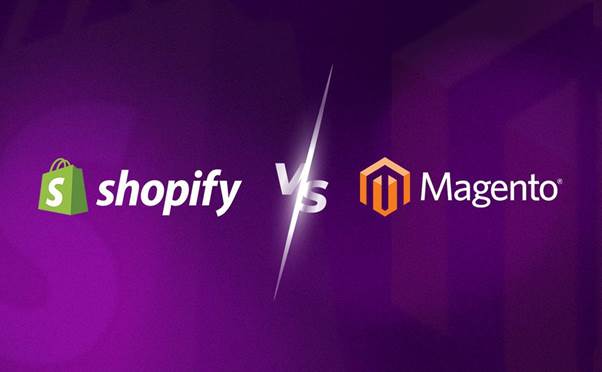The best eCommerce platform can help you pave the way for launching a ground-breaking successful online store. A platform must be equipped with several handy features that help to quickly build attractive and engaging eCommerce sites.
Online business owners are obsessed with choosing between Magento and Shopify, the two leading platforms worldwide. While Shopify holds a substantial share of the eCommerce market, Magento offers robust reporting features. Both platforms have a fair share of benefits and drawbacks. An eCommerce agency can help you build a thriving & eye-catching online store that drives ROI.
In this blog, we inspect the Magento vs Shopify differences in detail. By the end of this blog, you can easily choose between the two platforms for your needs.
What is Magento?
Magento is a leading, open-source eCommerce platform that helps you build cost-effective online stores with robust functionality. It provides users with full access to its backend code—unlike Shopify, which is a fully hosted solution. The platform itself is written in PHP and built on frameworks such as Symfony and Laminas; Magento uses MySQL or MariaDB databases, requiring developer setup and ongoing maintenance.
Magento is a trusted choice by many high-profile brands like Omega and Dior. In 2018, Magento was acquired by Adobe, leading to its integration within the Adobe Commerce ecosystem.
Pros of Magento
- Magento is open-source in nature and this paves the way for extensive level of personalisation. Anyone can tailor the platform to build a Magento store that fulfills specific needs.
- It can handle large product catalogs, high traffic, and complex business processes, making it suitable for growing businesses.
- The platform comes with robust SEO features that help online stores rank higher in search engine result pages (SERPs).
- It has a large and active community that provides ample resources, support, and extensions for Magento users.
- A Magento web agency can integrate your site with various channels and systems. This allows businesses to manage their sales across multiple platforms.
- It has many built-in features, including advanced reporting and product management tools.
Cons of Magento
- Building and maintaining a Magento store can be expensive, especially for complex customizations and integrations.
- Magento’s complexity can make it challenging for beginners to learn and use effectively.
- Building a Magento store requires a strong understanding of the platform’s architecture and proven technical skills. In the Shopify vs Magento comparison, this gives Shopify a good lead, which is easy to use and manage.
What is Shopify?
Shopify is a leading, fully hosted commerce platform designed to help businesses sell both online and in person. From startups to global brands, millions rely on Shopify to build online stores. The platform lets you manage sales across web, mobile, social media, marketplaces, and physical locations like pop-ups or retail shops.
As a centralised solution, Shopify removes the burden of managing infrastructure and allows businesses to focus on growth. It offers a wide range of professionally designed website templates and a user-friendly backend for managing products, inventory, orders, and payments. Understanding how Shopify works can help you make a well-informed decision on whether it is the right fit for your eCommerce endeavour.
Pros of Shopify
- Shopify is known for its user-friendly interface. This makes it accessible to businesses with little to no technical expertise. It has a clutter-free drag-and-drop interface that simplifies store setup and management.
- You can choose from a wide range of free and paid themes. A Shopify agency can customise themes to build a store that matches your brand identity.
- The Shopify App Store provides a vast selection of apps that extend the platform’s functionality. So, businesses can add many features like email marketing, social media integration, and more.
- This eCommerce platform can handle growing businesses, allowing them to scale up their operations without major platform changes.
- Shopify provides SSL certification, automatic updates, and regular security patches. This ensures greater store security.
- Shopify offers around-the-clock support via various channels, including live chat and email.
Cons of Shopify
- Advanced content creation and management on Shopify can be challenging. You need good coding knowledge and skills for higher personalisation.
- While Shopify offers a variety of themes, deeply customizing them requires knowledge of Shopify’s Liquid coding language.
- Merchants need to pay additional transaction fees when using third-party payment gateways.
Shopify vs Magento – In-depth comparison
1. Ease of Setup & Use
Shopify is an all‑in‑one, hosted ecommerce solution. It requires minimal technical know‑how, with server maintenance and security handled by Shopify itself. In contrast, Magento demands self‑hosting, security management, and ongoing technical resources. For many, Shopify’s plug‑and‑play simplicity is a decisive advantage.
2. Personalisation
Magento offers extensive flexibility—ideal for businesses needing deeply customised systems. Shopify, while highly customisable through its Liquid templates and large app ecosystem, typically suits stores that don’t require deep backend modifications.
3. Inventory & International Sales
Magento excels with out‑of‑the‑box advanced inventory and fulfilment features, plus strong international support. Shopify covers these needs via apps and builtin tools, offering a solid international experience too.
4. Hosting, Performance & Security
Shopify handles hosting, PCI compliance, and traffic surges. Its infrastructure supports thousands of transactions per minute. Magento, on the other hand, leaves server performance, hosting, and security entirely to you. So, scalability depends on your setup.
5. Support
With Shopify, 24/7 support is included. Magento lacks official round‑the‑clock assistance, necessitating either an in‑house tech team or an agency partnership.
6. Costs & Ongoing Development
Shopify operates on a subscription model—from basic to enterprise (Plus). Costs are predictable and scale with usage. Magento imposes higher initial development costs and ongoing maintenance due to server and customisation demands.
7. Scalability
Shopify scales effortlessly, managing traffic spikes without downtime. Magento can do the same—but only if you invest significantly in infrastructure and expert development.
8. Technical Debt
Magento’s customisations can lead to complex, hard‑to‑maintain codebases. Shopify’s managed environment reduces this risk and maintenance overhead.
Conclusion
Both Shopify and Magento are powerful ecommerce platforms—but they’re tailored to different needs:
- Shopify is best for ease of use, scalability, predictable costs, and minimal maintenance. It suits a wide range of businesses, from startups to fast‑growing enterprises.
- Magento is well‑suited to companies needing deep backend customisation, advanced fulfilment capabilities. It provides full control over hosting and security, but you need a good technical team or agency to support this.
Shopify often emerges as the clear winner for most growing brands, given its user‑friendliness, scalability, and support. Magento still holds appeal for enterprise-level stores that need intense technical customisation. You can choose any of the two as per short and long-term business goals.



